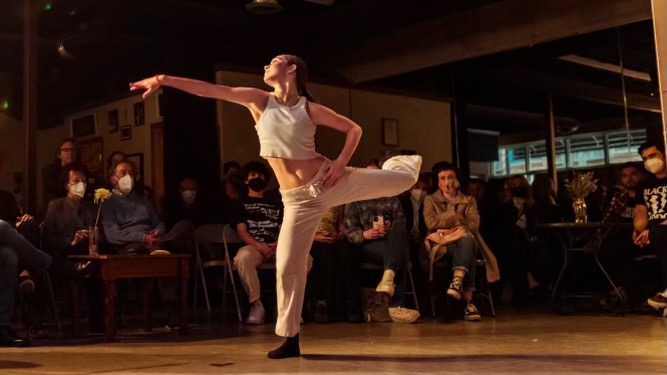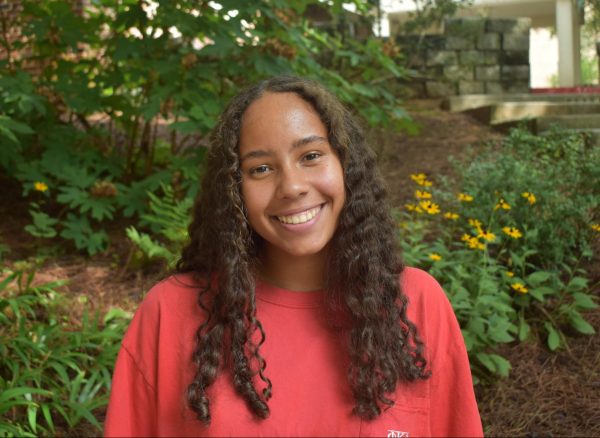Students find joy in the art of dance
Junior Jo Anderson performs a lyrical piece during her sophomore spring show at Yara Dance Studio.
May 17, 2023
Defined as a series of movements that match the speed and rhythm of a piece of music, dance plays a large role in the physical and mental development of students around the world. From ballet to lyrical dancing, several students at Midtown share a love for the art.
Senior Sam Prausnitz-Weinbaum fell in love with ballet when he started classes in fifth grade. He now dances at Dance Foundry studio in Scottsdale.
“When I’m dancing, doing all the big leaps and jumps makes me feel powerful flying through the air,” Prausnitz-Weinbaum said.
After trying out gymnastics and tennis, Prausnitz-Weinbaum focused on ballet, acknowledging the beauty of the sport.
“When I was doing gymnastics, it was very competition-focused,” Prausnitz-Weinbaum said. “You would train to compete and be scored and ranked, which is mostly why I quit because of the competitiveness. The main difference between ball sports and ballet is that your goal is the same throughout, just trying to hit it over the net or return the serve, but in dance, there’s infinite possibilities for choreography, and you’re just trying to execute that dance or that movement to your best ability with a lot more variety.”
In the female-dominated field of dance, Prausnitz-Weinbaum recognizes a difference when it comes to performing ballet.
“It’s definitely different as a guy,” Prausnitz-Weinbaum said. “Classically, there’s different steps that are traditionally male and female and then there’s also things like partnering, where the man is supporting the woman through all of her steps. This year, we have a syllabus where we learn dances, and there is a separate male and female syllabus, whereas, in the past, they had been combined with small differences, but now they’re totally different, and I do have my own male class.”
Junior Josephine Anderson performs a variety of dances, including modern, contemporary, jazz, lyrical and ballet. Lyrical is her favorite.
“Lyrical is the most expressive, and the easiest for me to understand,” Anderson said. “[Dance] is physical activity, so it’s my version of a sport or just releasing energy out in a healthy way.”
In addition to physical wellness, Anderson has developed relationships through dance that have continued to flourish throughout the years.
“I’ve been dancing with about the same ten girls since my company formed, so we all know each other really well,” Anderson said. “It’s gone from being dance friends to hanging out outside of dance. Our teachers — we have a really close relationship, too and it’s great to have close relationships with people that care about making you the best dancer you can be.”
Senior Elena D’Agostino shares a similar experience, forming relationships through Dance Foundry studio with people outside of Midtown.
“I’ve made a lot of close friends,” D’Agostino said. “Almost no one at my studio goes to school with me, or they’re in a different grade, so I’ve made friends from other schools. My teachers have been such prominent figures in my life because I see them so many times a week. They’ve become mentors.”
Similar to other activities, dance can often be a large commitment, physically and mentally.
“It’s more of a mental challenge rather than a physical challenge with the amount of time that you’re there,” Anderson said. “If you’re really committed, you’re usually there most days, if not every day of the week, and just pushing yourself to do the types of dances you don’t usually like and continuing to do it can be difficult.”
Prausnitz-Weinbaum believes patience is key to success and continuing to thrive when faced with difficult situations.
“One of the hardest aspects is that it takes a lot of patience and a lot of work to dance at a proficient level,” Prausnitz-Weinbaum said. “That can be frustrating sometimes when you feel like you should be able to do a step after weeks of practicing it, but you’re still not perfect at it. On the flip side, when you do eventually get it, it’s very rewarding.”
As an injury-prone activity, D’Agostino understands the dedication it takes to come back better than how you left.
“There’s no shortcut, especially after an injury, you have to work hard because there’s no easy way to get back into it,” D’Agostino said. “If you put in the work, you can see improvement, but if you don’t, it’s very clear, which is a lesson you can apply to other areas in your life.”
Prausnitz-Weinbaum sees the importance in getting out of your comfort zone and trying something new to create opportunities for yourself to improve.
“It’s better to try and fail than not try at all, like missing 100% of the shots you don’t take,” Prausnitz-Weinbaum said. “It can take a while to perfect something, but you can’t just go in expecting to be perfect. You really have to apply yourself which goes for everything, not just dance.”







